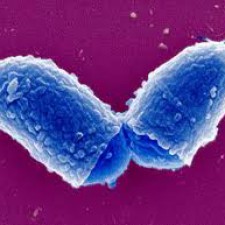Discussion:
You must be logged in to reply to this topic.
- Clostridium perfringens
-
April 8, 2013 at 2:31 am #13278

coberhausenMemberI am a gram-positive (blue in a gram stain), non-motile, rod-shaped, anaerobic, spore-forming bacterium. My cell walls are typical of a gram-positive bacterium – they are thick, and made of peptidoglycan surrounding an inner membrane. As an anaerobe, I acquire energy by performing anaerobic respiration using nitrate. I can also undergo anaerobic fermentation to produce gases, such as carbon dioxide – this increases my survival rate by creating an anaerobic environment in my host human (where I like to take holidays). I can also carry out the process of glycolysis.
I can be found everywhere! I am a normal component of decaying vegetation, marine sediment, soil, and can be found in the intestinal tracts of humans and animals. However, I am most commonly found on raw meat and chicken. What can I say? This is where I go when I need a holiday. From the raw meat or chicken, I enter my host – preferably human and animal in nature. When I’m on holiday, I like to have fun – live it up. You’ll know I’m visiting you (or your pet doggy) when you notice watery diarrhea and abdominal cramps within 6 to 24 hours of ingesting me. I come on suddenly and I last for about 24 hours – my holidays always go fast (unless you’re an infant or elderly), but I always have fun. Then it’s over. I don’t give you a fever, I don’t cause vomiting and I can’t even extend my trip to another locale because I can’t be transmitted from human to human – major bummer, but I guess we all have our faults. The toxins I produce inside your body cause many gastrointestinal illnesses with severity ranging from mild enterotoxaemia to fatal gas gangrene. The virulence factors that cause the various illnesses include, alpha, beta, epsilon and iota toxins – though alpha tends to be the most impressive because it causes the toxins necessary to produce gas gangrene in my host. What I am most proud of, however, is that I am one of the most common sources of foodborne illnesses in the United States! Not too shabby.
I’m related to all the Clostridiums of the world – and let me tell you, we are a dysfunctional but fun family to be around. Some of my family members include, C. tetani (a.k.a., tetanus), C. botulinum (a.k.a., botulism) and C. difficile (a.k.a., C. diff) just to name a few. The Clostridiales family is located on the Low G+C Gram-Positives tree – under Produce Endospores. I suppose our cousins might include the Bacillales family, although they are aerobic and facultative anaerobes – whereas us Clostridiums are the real deal, anaerobes all the way. Other friends in our tree include the Mycoplasmatales and the Lactobacillales.
References:
http://microbewiki.kenyon.edu/index.php/Clostridium_perfringens
http://www.cdc.gov/foodborneburden/clostridium-perfringens.html
http://en.wikipedia.org/wiki/Clostridium_perfringens_alpha_toxinApril 11, 2013 at 5:49 am #16806
Anna NagulaMemberHello Clostridium perfringens! My name is Corynebacterium diphteriae and I would like to become your friend because we have a lot in common. For example, we both are Gram positive, rod shaped and non motile pathogens. You seem as outgoing and fun because you visit humans and pets on the holidays.
April 14, 2013 at 12:09 am #16828
evelynMemberHi this is your family member C. botulinum. Just wanna say hello
You must be logged in to reply to this topic.


